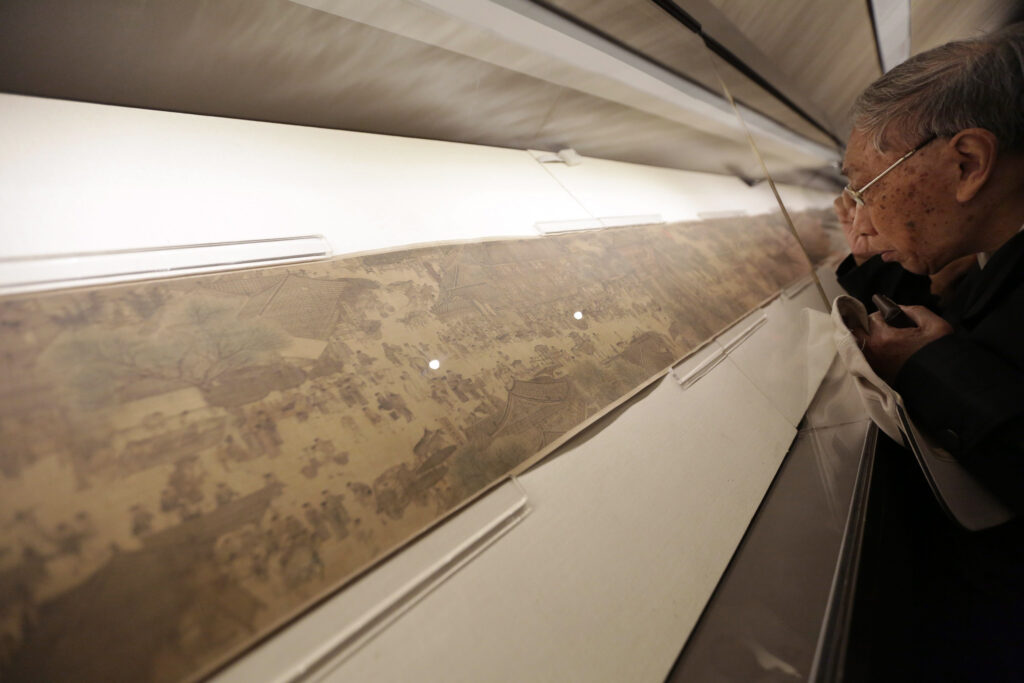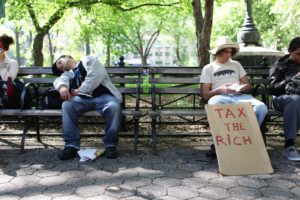Goodbye, Gibbon

Sometime in the mid-12th century, a Chinese poet named Lin Sheng traveled 365 kilometers from his hometown Pingyang to Lin’an—what is now Hangzhou, a city on the southeast coast, where the tech giant Alibaba is based.
Lin stayed at a B&B and roamed the city for days. He climbed various hills, drifted through Buddhist temples, sampled an assortment of crabs, shrimps, lamb, and sweet rice, all marinated in alcohol—a culinary specialty of the region—and, like today’s tourists, spent a significant amount of time on and around the impossibly beautiful West Lake, the sin and soul of Hangzhou.
Hangzhou is glorious on summer nights. The lake lies sultrily within the warm embrace of the hills, blue as sapphire. When the breezes pick up in the evening, as they always do, the water undulates like dancers’ long, silky sleeves, gleaming with reflections of candles in the boats and pavilions, homes on the hills, and lanterns carried by residents. And there was singing and dancing, lots of singing and dancing, deep into the orange night. Our delicate poet found himself both entranced and uneasy.
One morning, after the merriment had melted into dawn, Lin rose from his bed, inked his brush, and wrote on his chamber wall. This tiny poem, 28 characters light, would be memorized by every schoolchild in China almost a millennium later.
Hills beyond blue hills,
Pavilions beyond pavilions.
When will the singing and dancing on West Lake cease?
Travelers, drunk on a warm breeze,
Have mistaken Hangzhou for Bianzhou.
Bianzhou is today’s Kaifeng city, 900 kilometers southwest of Hangzhou in the inland province of Henan. Kaifeng’s GDP per capita in 2023 was about $7,500, one-third of Hangzhou’s.
Today’s hinterland was yesterday’s metropolis. Kai means to open, feng means to close; so Kaifeng literally means opening what’s closed—in this case, conquering new land. True to its name, Kaifeng was the capital city of no fewer than eight Chinese dynasties; the earliest is believed to have been the Xia dynasty (c. 2070–1600 BCE) and the last was the Northern Song dynasty (960–1127). Kaifeng today is charming yet unassuming. Only after a good, clean rain can one catch the petrichor of millennia lingering in the dampened stones and ancient streets.
Artists know Kaifeng from Along the River During the Qingming Festival (1101), perhaps the most famous painting in Chinese history. It’s been called China’s Mona Lisa, but Liberty Leading the People (1830) offers a better comparison. Both Along the River and Liberty capture consummate snapshots of their societies in the eras of their creators.
Yet the worlds they depict couldn’t be more different. Liberty is Eugène Delacroix’s (1798–1863) romantic rendition of the young French Republic, born from the violent revolutions of 1789 and 1830. “If I haven’t fought for my country, at least I’ll paint for her,” wrote Delacroix to his brother.
Along the River by Zhang Zeduan (1085–1145) couldn’t be less violent and revolutionary. Stretching over five meters, it’s estimated to contain 14 bridges, 28 boats, 30 buildings, 60 animals, 170 trees, and hundreds of people (mostly men) from all walks of life going about their daily business: buying, selling, playing, hustling, or just chilling. Had Delacroix painted it, he might have called it Prosperity Leading the People.
Lying beneath the festive surface of Along the River, however, are Zhang’s hidden warnings to the emperor. Upon closer inspection, we see hints of crisis: startled horses, boats on a collision course, smoke curling from wooden edifices, and soldiers napping at midday. Indeed, only two decades later, the Jurchens would lay siege to Kaifeng, capturing Emperor Qinzong. His father, Emperor Huizong, fled south to Hangzhou and founded the Southern Song dynasty in 1127.
Not long after the emperor settled in Hangzhou, our poet Lin Sheng journeyed there and left his laments on a wall. To Lin, the singing, dancing, and revelry around West Lake were no more than the death throes of the Song dynasty, which would last for another hundred some years until the Mongols brought its end.
Death is the greatest fear of every human being. Decline and demise are the ultimate fears of every regime. For millennia, intellectuals have pondered decline, artists have steeped in its melancholy, and rulers have sought, often in vain, to forestall it. Without question, anxiety over personal mortality and dread over a nation’s, dynasty’s, or civilization’s end are deeply entwined.
The contemplation of decline goes hand-in-hand with the quest for eternal life. Religions offer solace with promises of an afterlife. Billionaires invest in medical breakthroughs. Dictators soak their dead bodies in silicon dioxide. Intellectuals pine, mostly delusionally, for the timelessness of their names and works. For the common person, the nation promises the everlasting by linking the fates of individuals who, when all is said and done, have little to do with one another—and may well loathe and fight each other if they met in real life. Yet nationalism creates the illusion of an eternal “people,” whether this people is 5,000 or 250 years old, granting mortals a comforting sense of permanence, a way to have lived before and to live beyond.
All this is to say that “Is America in decline?”—the question for this special issue—is not merely empirical but existential. It reflects our most basic fears. Because of its essential human quality, this question has doppelgängers throughout the historical record. Some version of it has echoed, in various forms, in various places, across the tiny speck of world history that is human.
The puzzle of decline was most famously tackled—with the benefit of centuries of hindsight—by Edward Gibbon in his six-volume magnum opus produced at the height of Enlightenment. The History of the Decline and Fall of the Roman Empire (1776–88) documents that empire’s gradual erosion brought on by military exhaustion, moral and material decadence, and the ascendance of Christianity, which weakened the Romans’ civic virtue and commitment. Gibbon revolutionized the field of history and cemented the timeless allure of decline as an intellectual puzzle.
Gibbon’s descendants have revisited the decline thesis in depth and at length in paint and ink. Decline was the opium of the Romantics, epitomized magnificently in J. M. W. Turner’s The Decline of the Carthaginian Empire (1817) and Thomas Cole’s The Course of Empire (1833–36). Declinism surged in the twentieth century as Western intellectuals pondered the fallout of modernity. Most notably, Oswald Spengler’s The Decline of the West, published around the time of World War I, compared civilizational trajectories to the life cycles of organisms, predicting the Untergang (downfall) of the “evening land”—that is, the West—to be followed by an age of Caesarism led by authoritarian figures. The fatalism in Spengler’s work echoed his contemporaries’ racial and cultural anxieties, which would eventually be exploited by modern—or perhaps anti-modern—Caesars.
Declinist thought persisted after World War II, taking root in a land that was by all means on the rise: the United States. In the 1970s declinism was over the Vietnam War; in the 1980s declinism was over Japan. Despite the fall of the Soviet Union and America’s triumph in the Cold War, the 1990s and the first decade of the 2000s were also steeped in declinism, as in Samuel Huntington’s The Clash of Civilizations (1996) and Who Are We? (2005). In contemporary discussions about American decline, Gibbon’s fallen empire frequently resurfaces, inspiring symposiums with titles like “Is America the New Rome?”
Today, declinists find themselves on opposite sides of the ideological spectrum. Decline is the demagoguery of some and the despair of others. Some declinists thunder from campaign rostrums, others pontificate from the ivory tower.
The task I’ve been given is to explore a Chinese perspective on the question “Is America in decline?”—to the extent that the Chinese consider this question at all, and with the understanding that a thousand Chinese people may have a thousand different answers.
In these turbulent times, there is a certain comfort in surrendering to the narrative of being threatened, undermined, or taken advantage of. I won’t lean into that sentiment here, as readers can find plenty of it elsewhere. Instead, my response is that the question may be ultimately unanswerable, because many Chinese tend not to view dynastic, imperial, and civilizational decline through the same interpretive lens as their European and American counterparts.
Let’s go through the Chinese story again, starting shortly after the apex of the Northern Song dynasty in the 12th century, when Along the River was painted. Northern Song prosperity eventually gave way to decline and fall, followed by the rise of the Southern Song dynasty around West Lake, which, too, experienced decline and fall (in 1279). The storyline continues: Then rose the Yuan dynasty, which also declined and fell (in 1368), to be replaced by the Ming, which was superseded (in 1644) by the Qing, before a revolution led to a Republic (in 1911) and another revolution established a People’s Republic (in 1949).
There is a hackneyed term for this storyline: “dynastic cycle.” Though often abused by its proponents and criticized by its opponents, the concept remains influential in mainstream Chinese historical thought. The idea is simple: A new dynasty rises from the ashes of an old one. Its founders are given the mandate to rule by heaven because they are strong and benevolent. The ruling group leads the dynasty into a golden age. But over time, the rulers become corrupt and complacent, and the dynasty enters decay and turmoil. In the final stage, the dynasty is too weak to resist rebellion or invasion. A new ruling group comes to power, commencing the cycle anew, fresh with virtue, strength, and legitimacy. “How to escape the dynastic cycle” is a topic Chinese elites have puzzled over, from the Chinese Communist Party’s theoreticians to the nation’s top leadership.
There are some similarities between the Chinese and Roman storylines. In particular, decline is often attributed to the decadence of those in power and in society—the debauched theaters and public baths in Rome, and the carefree singing and dancing on West Lake. Material decline is also always interpreted through a deeply moral lens: We declined because we became complacent, too comfortable; we declined because we forgot who we are. We are not supposed to be enjoying baths and throwing parties when our homelands are in trouble.
Nonetheless, significant differences in thinking stand out. First, Western historiography generally follows a linear trajectory. Conservative thinkers like Spengler have proposed more cyclical theories of history, but even in Spengler’s analysis, each civilization goes through the cycle of birth-growth-peak-decay only once, with the Western civilization, the focus of his analysis, nearing its end. While not necessarily linear in a Hegelian or Marxist sense, Spengler’s cycle isn’t cyclical either, as history does not repeat in the same place.
Second, while the rises and falls in European historiography seesaw geographically between different civilizations, the dynastic cycles in Chinese historiography rotate internally along the wheels of time, with Chinese civilization always at its center.
The European story is often framed as a successive march of top dogs in a pageant of Paxes. Something like: The fifteenth century was the Portuguese century, the sixteenth century was Spanish, the seventeenth century was Dutch, the eighteenth century was French, the nineteenth century was British, and the twentieth century was American. Of course, even before all that, we had Athens overtaken by Sparta and the Byzantines bending the knee to the Ottomans. The civilizational game is exactly like the computer game Civilization. Every time an old civilization falls, a new civilization rises. Only one civilization survives in the end. By this logic, the rise of Japan, China, or whichever the next up-and-coming economy is, must come at the cost of America’s decline.
The Chinese story is told differently. One of the first things American college students learn in a course on China is that “China,” or Zhongguo in Chinese, means the “Central Kingdom.” They are told that this suggests China has historically seen itself as the center of the world. Some attribute this to China’s geography and its agriculture-focused economy. As a result, Chinese culture is often described as inward-looking, in contrast to Europe’s outward-looking, adventurous, seafaring civilizations. Until the Opium Wars, China’s attention was turned mainly toward herself. This is why China never became the kind of global imperial power that Europe or the US did. And the flipside of an inward orientation is an attitude of “mind your own business.”
Within China, the dynastic-cycle view implies that any new ruling group, however “barbaric,” would become a Chinese dynasty and be absorbed into the civilizational mothership. The official story goes that the Jurchens embraced Confucianism, the Mongols accepted religious pluralism, and Manchu emperors became patrons of Chinese literature and the arts (although they banned the abhorrent practice of foot-binding). All of them relied on the imperial bureaucracy.
Revisionist historians have criticized the Sinocentrism of this master narrative, with careers made and broken over the controversy of how Sinicized China’s ethnic rulers truly were. Others challenge the conservative reading of the dynastic cycle, arguing instead that these cycles push history in a generally progressive direction. With each new dynasty correcting its predecessor’s mistakes, new errors inevitably emerge, only to be addressed by the dynasty that follows. This cyclical yet progressive view of history aligns with certain aspects of Hegelian philosophy.
But to address the question “Does China think America is in decline?” it’s not so important to focus on what has objectively happened. More relevant is what people believe has happened. The regnant Chinese perspective on the rise and fall of dynasties differs from the linear, universalizing, and zero-sum perspective preponderant in the West.
So you’ve heard enough about Chinese dynasties. What about Xi Jinping, then? Didn’t he invoke the idea that “The East is rising and the West is declining”? Yes, but Xi was far from the first to say that. Once the Westphalian system was imposed on the non-European world, newly independent countries in Africa, Asia, and the Middle East began to position themselves in relation to the West. Asia, in particular, is said to have “risen” thanks to its newly wealthy states. Long before China became the world’s second-largest economy, Asian leaders like Prime Minister Lee Kuan Yew of Singapore and Prime Minister Mahathir Mohamad of Malaysia exalted “Asian values” and Asian development models, announcing their ambition to catch up with the West.
Yet catching up is not the same as replacing. When Chinese leaders muse about the decline of the West, what they are saying is that the West is no longer a model for China, however correct or incorrect this conclusion may be. When Chinese state media play footage of looting on Chicago’s Michigan Avenue or police brutality in Ferguson, Missouri, they are telling viewers that the United States is not the kind of shining city on the hill it makes itself out to be. The message is not to go help America restore social stability with Confucian values. For better or for worse, the Chinese worldview, while by no means static, is still quite particularistic, in contrast to the more universalizing worldviews of the Christian tradition.
So my answer to “Do the Chinese think America is in decline?” is the following: We should be careful not to let a question turn into a prophecy. Rises and falls need not be an inter-civilizational zero-sum struggle, however seductive Thucydides’ lair may seem. Rather than getting swept up in the collective effervescence of status anxiety, only to look for an elixir in the intellectual Viagra of declinism, perhaps we should forget Gibbon.
Iza Ding is an Associate Professor of Political Science at Northwestern University and the author of The Performative State (Cornell University Press, 2022). She is spending the 2024–25 academic year in Berlin, in the fall as an Ellen Maria Gorrissen Fellow at the American Academy in Berlin and in the spring at the Hertie School of Governance.


